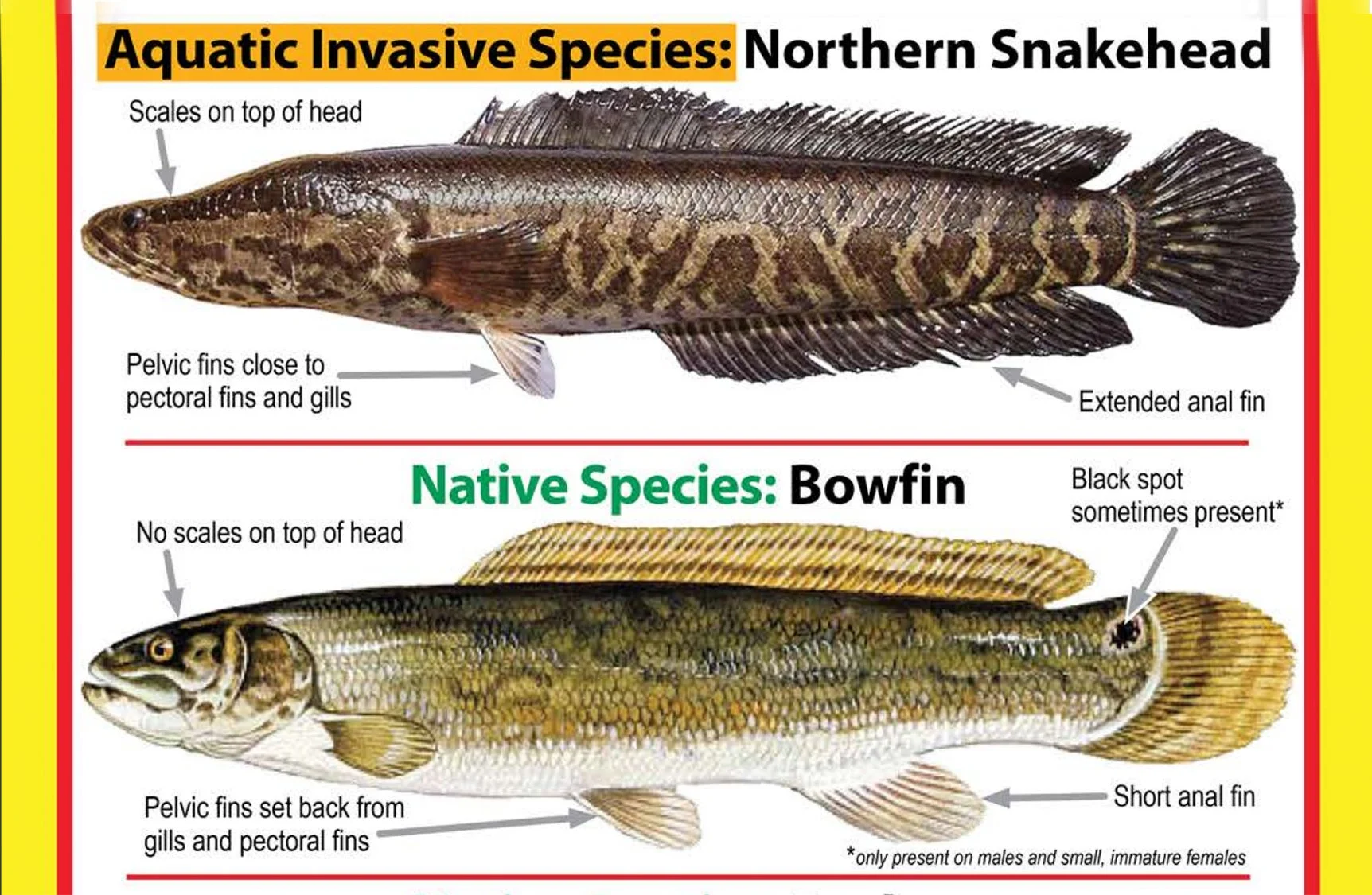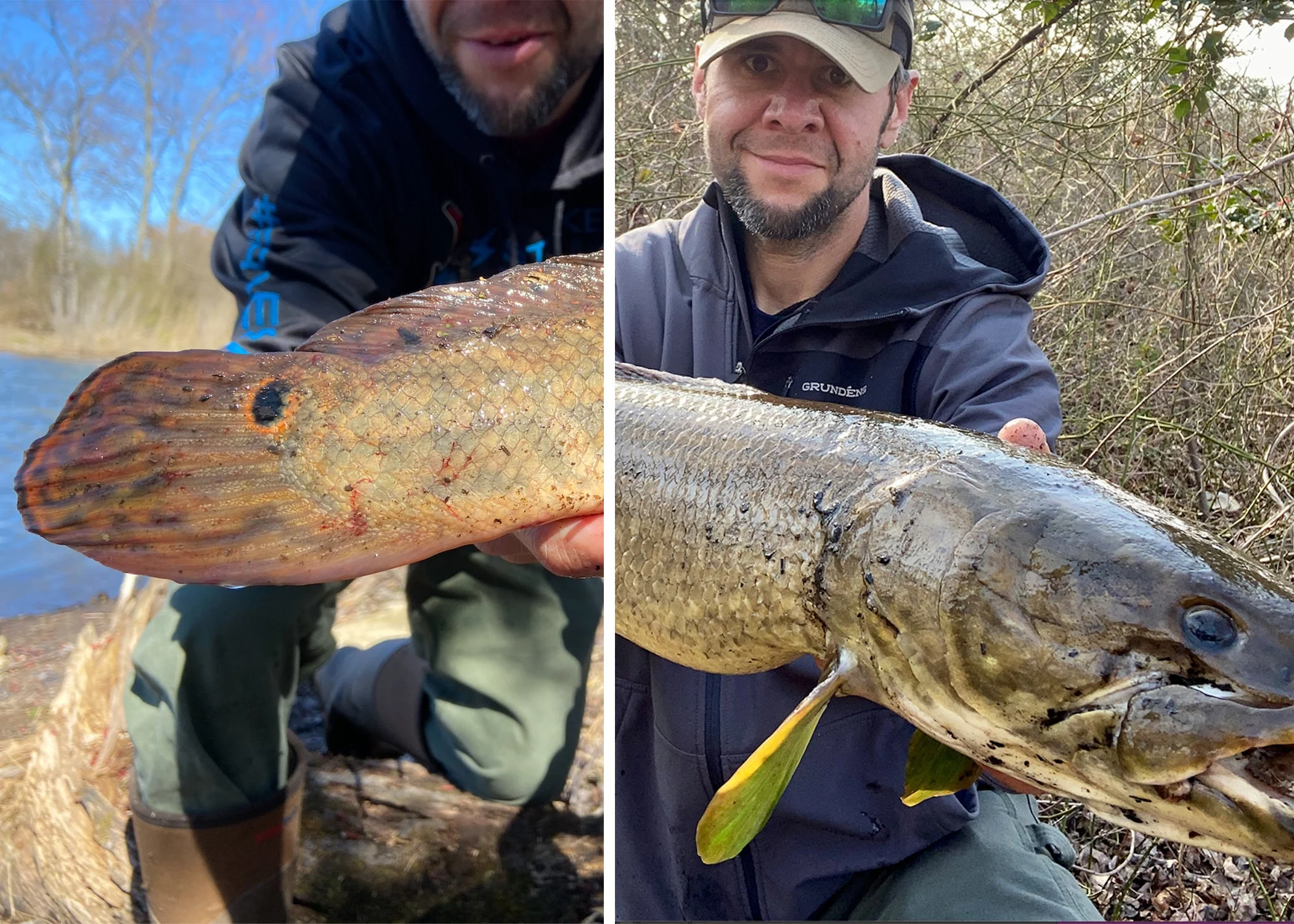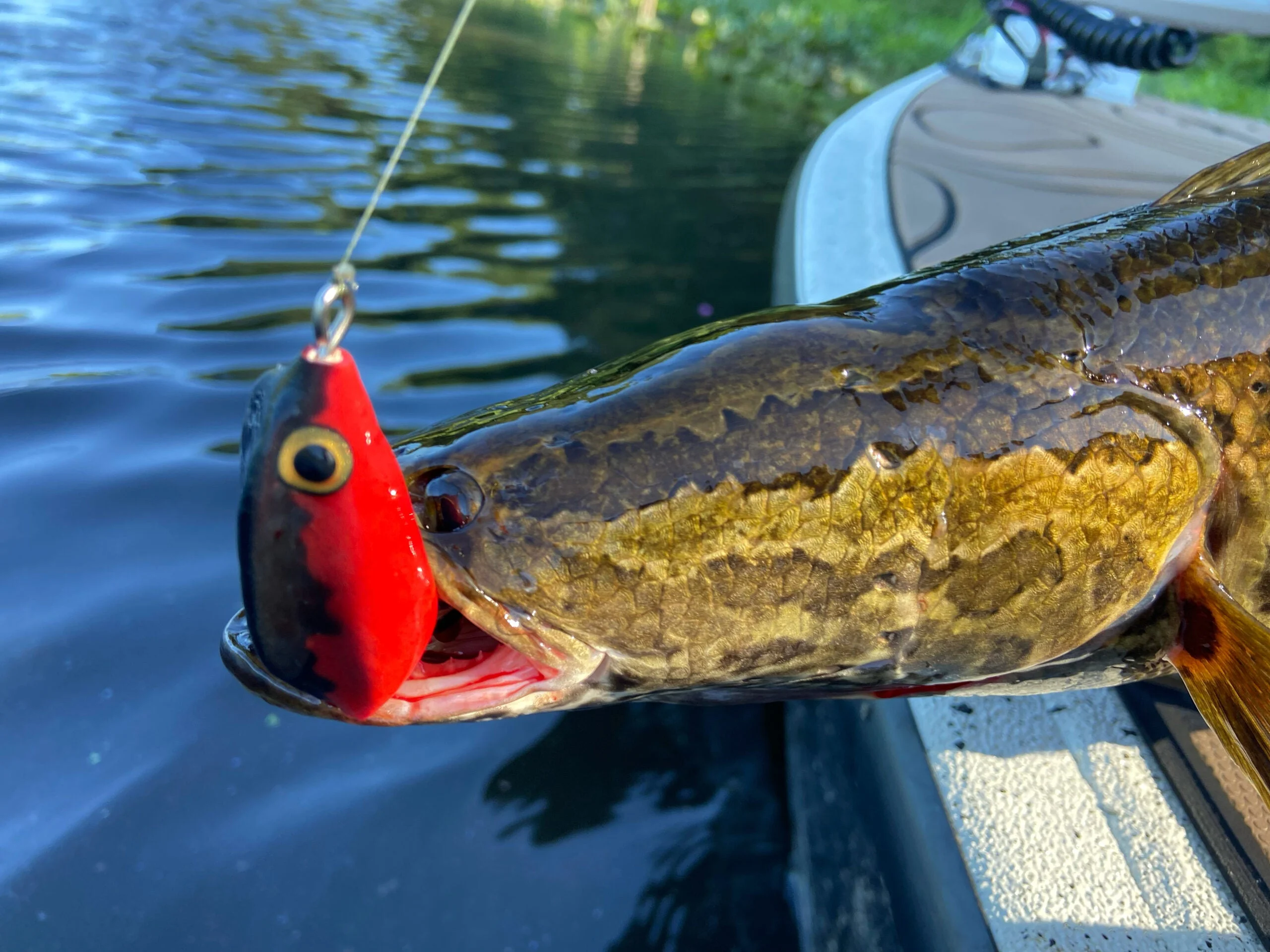_We may earn revenue from the products available on this page and participate in affiliate programs. Learn more ›
_
The question of bowfin vs snakehead isn’t so much a matter of which is better—but of which is which. These long, snake-like fish are easily confused with one another. And that’s a problem, because whereas snakeheads are an invasive species often targeted for removal, bowfins are native fish that require a level of protection.
The good news for anglers is that both, while overlooked and often underappreciated, are hard-fighting fish well worth targeting. That is, as long as you know how to tell them apart. So, here is a bowfin vs snakehead breaking, including how to ID and catch them.
Table of Contents
Distribution and Reputation
Physical Differences
Behavioral Differences
How to Catch Both
Bowfish vs Snakehead: Distribution and Reputation
No matter where you live, if you are into fishing—and maybe even if you’re not—you’ve heard about snakeheads. Twenty-plus years ago, this invasive species created a media firestorm when they were discovered in a Maryland pond. Native to Asia, it was feared these predators would dominate every body of water they populated, destroying all native species and permanently altering the ecosystem. More than two decades later, that hasn’t happened. In fact, little by little, the cult of anglers
that enjoys targeting snakeheads is growing.
There are two species of snakeheads living in the U.S.—the northern snakehead, which ranges from Virginia through Southern New York, and the bullseye snakehead, which lives in South Florida. While neither species has quite decimated the scene as once predicted, they have created some potentially harmful confusion because they thrive in waters that hold native bowfins. Though largely overlooked as a rod-and-reel target, the uptick in snakehead interest has meant more bowfins getting caught. The problem is they look very similar to snakeheads and, thanks to that media blitz in the early 2000s, many people still kill snakeheads, even though most states have relaxed the edict that none shall be returned to the water alive.
Bowfins are living dinosaurs. They have remained relatively unchanged since the Triassic period nearly 250 million years ago. They were here, along with species like the gars, long before every other gamefish we target today existed. That alone, at least in my opinion, should be enough for bowfin to earn some respect, yet for the most part they are considered a trash fish. They are native and widespread all across the eastern half of the county and in southeastern Canada, from Quebec west to Minnesota and from the Carolinas west to Texas.
Bowfin vs Snakehead: Physical Differences

This poster distributed by the Pennsylvania Fish & Boat Commission shows many of the key physical differences between the species. Pennsylvania Fish & Boat Commission
It’s easy to see why people these fish mixed up. Both have a long, almost snake-like body, a fairly flat head, and a rounded tail. The most striking—and perhaps confusing—similarity between bowfins and snakeheads is the dorsal fin. Both have long dorsals that begin in the middle of their backs and run all the way to the base of the tail. However, there are some key physical differences you can use to quickly tell them apart.
Bowfin
Bowfins range in color from gray to silver and brown to olive depending on the quality of the water they live in and time of year. During the spring spawn, the fins of a male bowfin can become vivid green. The color can be so intense, it’s as if someone took a highlighter marker to the fins. Males also have an eye spot on their tails that features a bright orange ring during mating season. Beyond the fleeting green fins and tail spots, bowfins can have a faint pattern of squiggly lines on their flanks, though they often have no pattern on the body at all.

Left: The tail spot seen on many male bowfin. Right: The bright green pectoral fins of a spawning bowfin. Joe Cermele
The head of a bowfin is rounded and blunt and there are no scales on top. One of the best ways identify a bowfin is by its anal fin, which is very different from that on a snakehead. Bowfins have a short anal fin positioned near the center of the belly, and it doesn’t extend very far at all, creating a much longer gap between the anal fin and tail compared to a snakehead.
Snakehead
Whereas bowfins exhibit little or no pattern on the body, snakeheads show vivid python-like rings and striations on their flanks year-round, even during summer spawns when the fish tend to darken in color. If the fish you are seeing appears almost black in the water, it’s a snakehead, although they can range in color from deep brown to vibrant copper.

Snakeheads show a vivid pattern on their flanks, whereas a bowfin’s are typically muted. Joe Cermele
A snakehead’s head is flatter than a bowfin’s, and the lower jaw extends farther. Snakeheads also have scales running all the way to the tip of their noses. Again, the anal fin is a key identifier. A snakeheads anal fin is much longer than a bowfin’s: it looks similar to the fish’s dorsal fin and runs from the middle of the belly to base of the tail, with none of the gap between anal fin and tail that you see on a bowfin.
Bowfin vs Snakehead: Behavioral Differences
Snakeheads and bowfins are both predators that hunt for live prey, and both species thrive in shallow, weed-choked, swampy waters, as they rely on vegetation for cover when hunting and spawning. But again, there are important differences.
Bowfin
Compared to snakeheads, bowfins spend a lot more time scavenge feeding. Although they’ll attack a small fish, crayfish, or frog on the surface, they have a powerful nose and are happy to eat dead or decaying forage off the bottom like a catfish. In fact, there’s no easier way to catch a bowfin than firing out a chunk of shad, shrimp, or bluegill under a bobber and waiting.
Bowfins tend to hold in place and wait for a meal to come to them, and I’ve found that success with bowfins on artificial lures often relies on getting your offering right in front of their faces, if not practically banging the lure off their snouts.
Snakeheads

Snakeheads are aggressive hunters and therefore more likely to slam a fast-moving lure. Joe Cermele
Snakeheads are roaming predators that tend to cover a lot of water when hunting. While they will occasionally grab a dead bait, you’ll find more success with them by presenting a moving target like a topwater frog
, buzzbait
, or Fluke
. Snakeheads will lock in on a moving target from a distance and track the bait before going in for the kill.
Bowfin vs Snakeheads: How to Hook and Land Both Species
One final trait these species share, of course, is toughness. Both have incredibly powerful jaws that happen to be rock hard, requiring a powerful, well-timed set to make a hook stick. It’s the primary reason why most anglers that target them lean on stout rods
and at least 40-pound braided line
.
Once you do get that hook planted, you’ve got to keep the pressure on and muscles the fish in fast, as even a moment of slack could cause the hook to fall right out. While snakeheads are still arguably the more glamorous of the two species, the reality is that bowfins are a bit meaner and stronger. It’s the take of a snakehead, which is similar to that of a muskie, that’s so addicting. When you set the hook, snakes go ballistic, but after that initial burst of energy, they typically come right to the net. Stick a bowfin, on the other hand, and that fish will battle you to the bitter end, doing everything in its power to break off or wrap you around the closest stump or lily pad cluster. Land either fish is an accomplishment worth sending a few pics to your buds.


